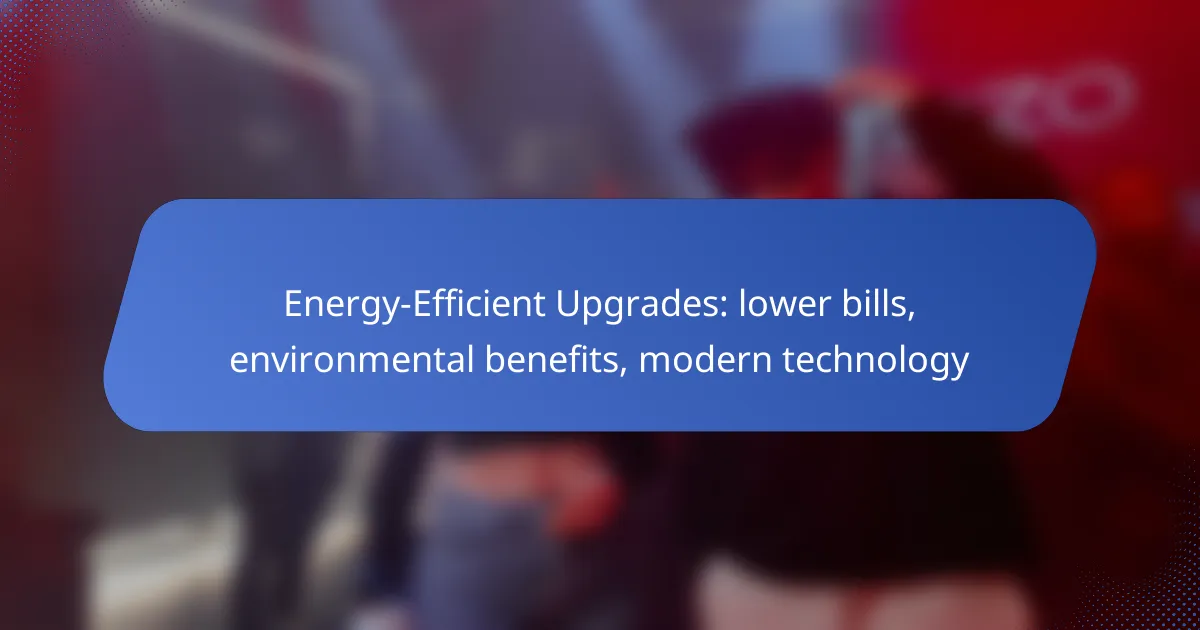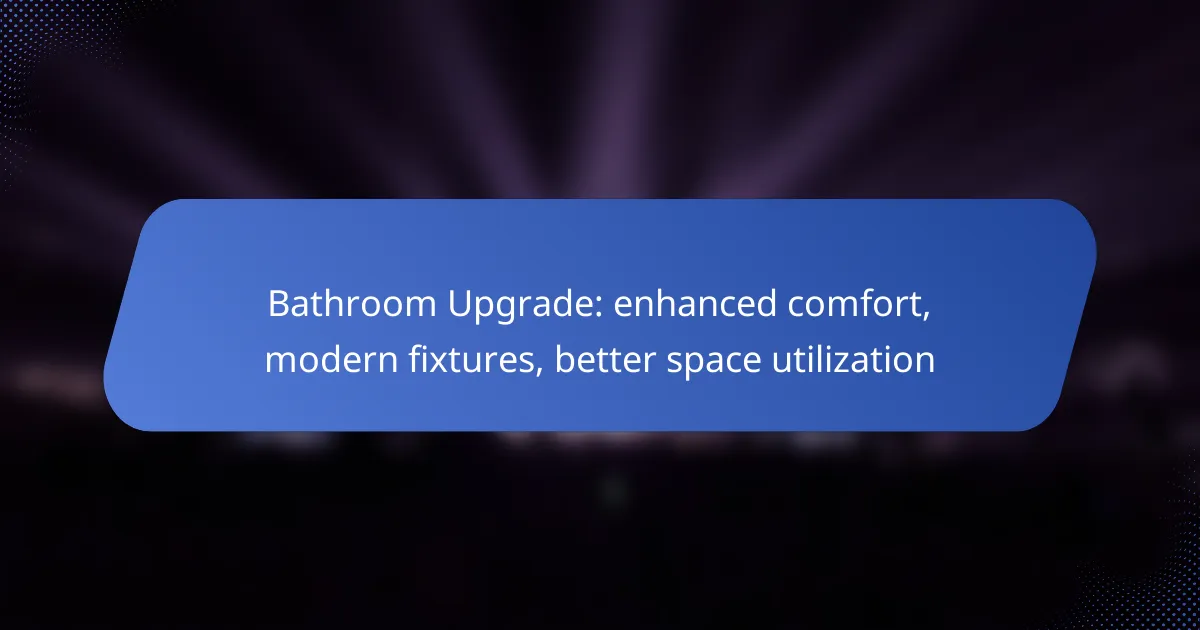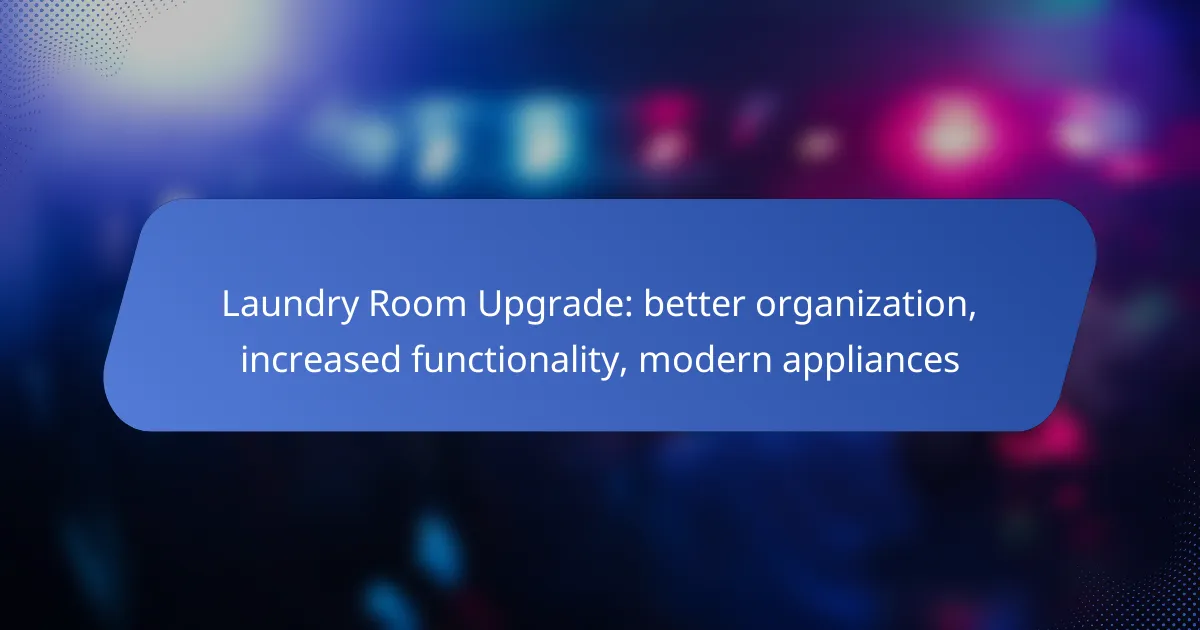Energy-efficient upgrades offer homeowners the dual benefits of reduced utility bills and a positive impact on the environment. By embracing modern technologies such as smart meters and home automation systems, individuals can optimize their energy consumption, leading to significant savings and a healthier planet.
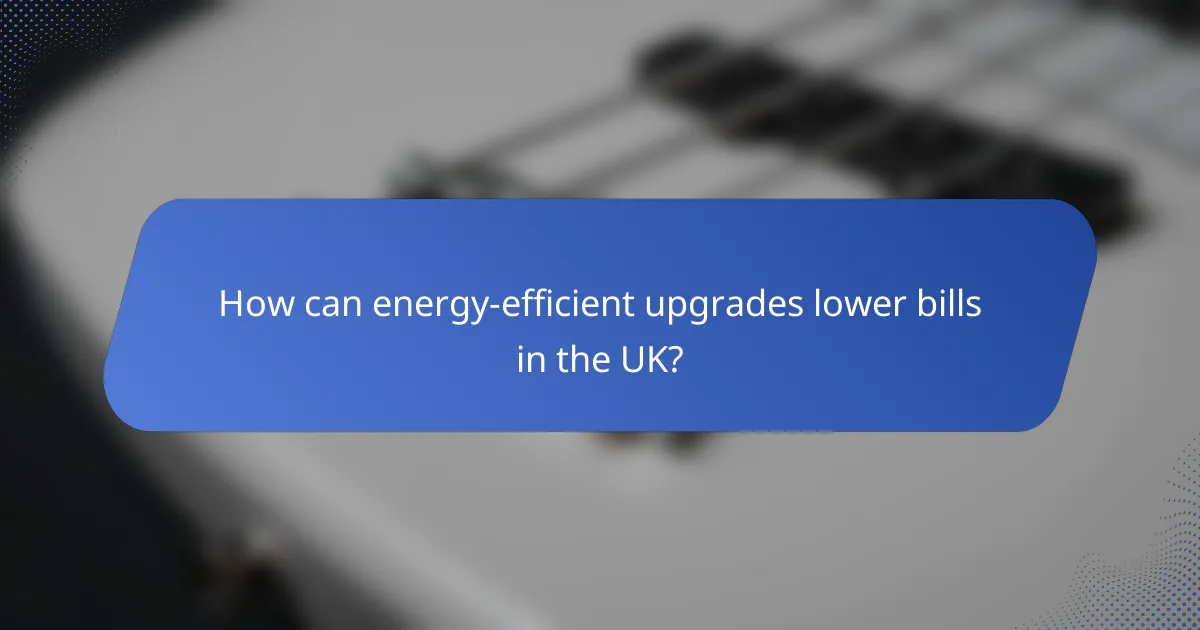
How can energy-efficient upgrades lower bills in the UK?
Energy-efficient upgrades can significantly reduce utility bills in the UK by minimizing energy consumption and optimizing usage. By investing in modern technology, homeowners can achieve lower costs while contributing to environmental sustainability.
Smart thermostats
Smart thermostats help manage heating and cooling more effectively, allowing users to set schedules and adjust temperatures remotely. By learning your habits, these devices can optimize energy use, potentially reducing heating bills by around 10-15%.
When selecting a smart thermostat, look for compatibility with your heating system and features like geofencing, which adjusts temperatures based on your location. Avoid models that lack user-friendly interfaces or require complex installations.
LED lighting
Switching to LED lighting can lead to substantial savings on electricity bills, as LEDs use up to 80% less energy than traditional incandescent bulbs. They also have a longer lifespan, reducing replacement costs over time.
To maximize savings, replace high-use fixtures first, such as those in living areas and kitchens. Look for bulbs with the Energy Star label to ensure efficiency and quality.
High-efficiency appliances
High-efficiency appliances consume less energy and water, leading to lower utility bills. Appliances with an A+++ rating are particularly effective, often using 30-50% less energy than standard models.
When upgrading, consider the long-term savings versus initial costs. Look for rebates or incentives from local energy providers to offset the purchase price of these efficient appliances.
Insulation improvements
Improving insulation in your home can significantly reduce heating and cooling costs by preventing heat loss. Proper insulation can lead to savings of 20-30% on energy bills, especially in older homes.
Focus on areas like attics, walls, and floors. Use materials that meet UK building regulations for energy efficiency, and consider hiring professionals for installation to ensure effectiveness.
Solar panel installation
Installing solar panels can drastically lower electricity bills by generating your own power. In the UK, homeowners can save hundreds of pounds annually, depending on system size and energy usage.
Research local incentives and the Feed-in Tariff scheme, which pays you for the energy you generate. Ensure your roof is suitable for solar panels and consider the initial investment versus long-term savings when making a decision.

What are the environmental benefits of energy-efficient upgrades?
Energy-efficient upgrades significantly reduce environmental impact by lowering energy consumption and minimizing waste. These improvements contribute to a healthier planet through reduced emissions and better resource management.
Reduced carbon footprint
Implementing energy-efficient upgrades leads to a lower carbon footprint by decreasing greenhouse gas emissions associated with energy production. For instance, switching to LED lighting or high-efficiency appliances can cut energy use by up to 75%, translating to fewer emissions from power plants.
Homeowners can further reduce their carbon footprint by utilizing renewable energy sources, such as solar panels, which provide clean energy and decrease reliance on fossil fuels. This shift not only benefits the environment but can also lead to long-term savings on energy bills.
Conservation of natural resources
Energy-efficient upgrades help conserve natural resources by reducing the demand for energy production, which often relies on finite resources like coal, oil, and natural gas. By using less energy, we can extend the life of these resources and promote sustainability.
For example, energy-efficient appliances often consume less water and electricity, which helps preserve these vital resources. Homeowners should consider Energy Star-rated products, as they are designed to use less energy and water without sacrificing performance.
Improved air quality
Upgrading to energy-efficient systems can lead to improved air quality by reducing emissions from energy generation and enhancing indoor air conditions. High-efficiency heating and cooling systems often include better filtration, which can remove pollutants and allergens from the air.
Additionally, using less energy reduces the pollutants released into the atmosphere, contributing to cleaner outdoor air. This is especially important in urban areas where air quality can be significantly impacted by energy production and consumption practices.
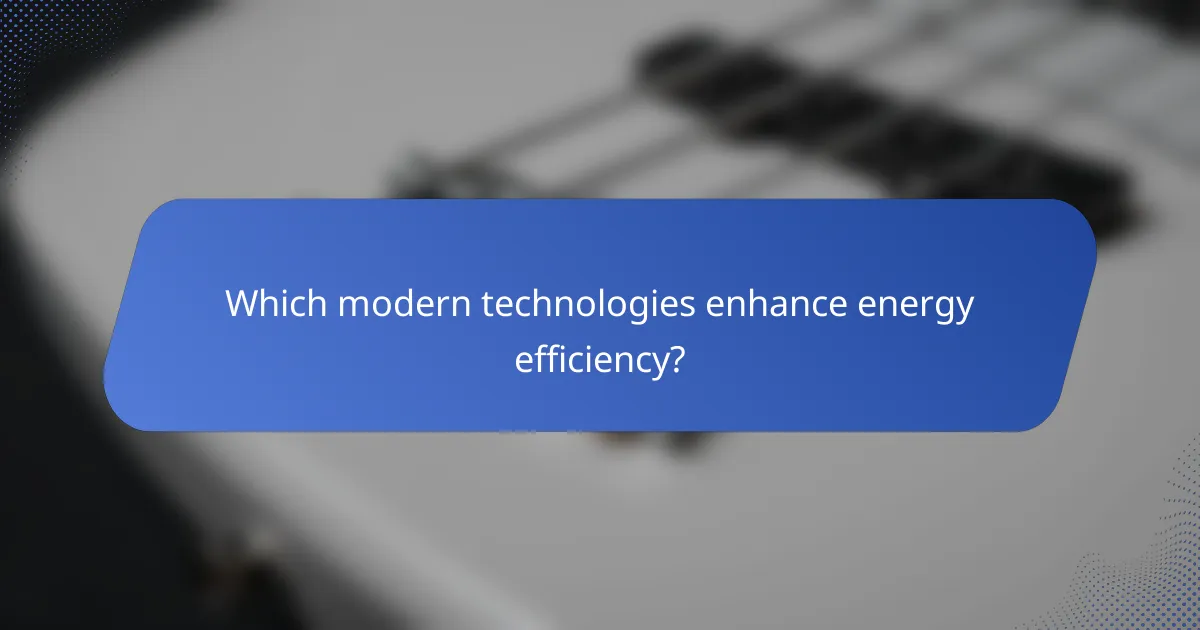
Which modern technologies enhance energy efficiency?
Modern technologies that enhance energy efficiency include home automation systems, energy management software, and smart meters. These innovations help reduce energy consumption, lower utility bills, and contribute to environmental sustainability.
Home automation systems
Home automation systems integrate various devices to optimize energy use throughout a residence. These systems can control lighting, heating, cooling, and appliances based on occupancy and preferences, significantly reducing unnecessary energy consumption.
For example, smart thermostats can adjust temperatures automatically when no one is home, potentially saving 10-20% on heating and cooling costs. When implementing a home automation system, consider compatibility with existing devices and ease of use.
Energy management software
Energy management software provides tools for monitoring and analyzing energy usage in real time. This software helps identify patterns and inefficiencies, enabling users to make informed decisions about energy consumption.
Businesses can benefit from such software by tracking energy costs and setting benchmarks for improvement. When selecting energy management software, look for features like customizable dashboards and reporting capabilities to suit specific needs.
Smart meters
Smart meters are advanced devices that provide real-time data on energy consumption, allowing users to track usage more accurately. These meters can help identify peak usage times and encourage energy-saving behaviors.
Many utility companies offer incentives for customers to switch to smart meters, which can lead to lower rates during off-peak hours. When considering a smart meter, check with local utilities for availability and potential cost savings associated with its use.

What factors should be considered before upgrading?
Before upgrading to energy-efficient systems, consider initial costs, long-term savings, and available incentives. Each factor plays a crucial role in determining the overall feasibility and benefits of the upgrade.
Initial investment costs
Initial investment costs refer to the upfront expenses associated with purchasing and installing energy-efficient technologies. These can vary significantly based on the type of upgrade, such as insulation, windows, or heating systems. For example, high-efficiency HVAC systems might range from a few thousand to over ten thousand USD.
When budgeting, include not only the equipment costs but also installation fees, which can add another 10-20% to the total. It’s essential to obtain multiple quotes from contractors to ensure competitive pricing.
Long-term savings potential
Long-term savings potential is the reduction in energy bills over time due to improved efficiency. Many energy-efficient upgrades can lead to savings of 20-50% on utility bills, depending on the technology and local energy costs. For instance, switching to LED lighting can significantly lower electricity expenses.
Consider the payback period, which is the time it takes for the savings to equal the initial investment. A payback period of 5-10 years is common for many upgrades, making them a sound financial decision in the long run.
Local government incentives
Local government incentives can significantly reduce the cost of energy-efficient upgrades. Many regions offer rebates, tax credits, or low-interest loans to encourage homeowners to invest in energy-saving technologies. For example, some states in the U.S. provide rebates for solar panel installations or energy-efficient appliances.
Check with local utility companies and government websites to find available programs. These incentives can sometimes cover a substantial portion of the initial costs, making upgrades more affordable and attractive.
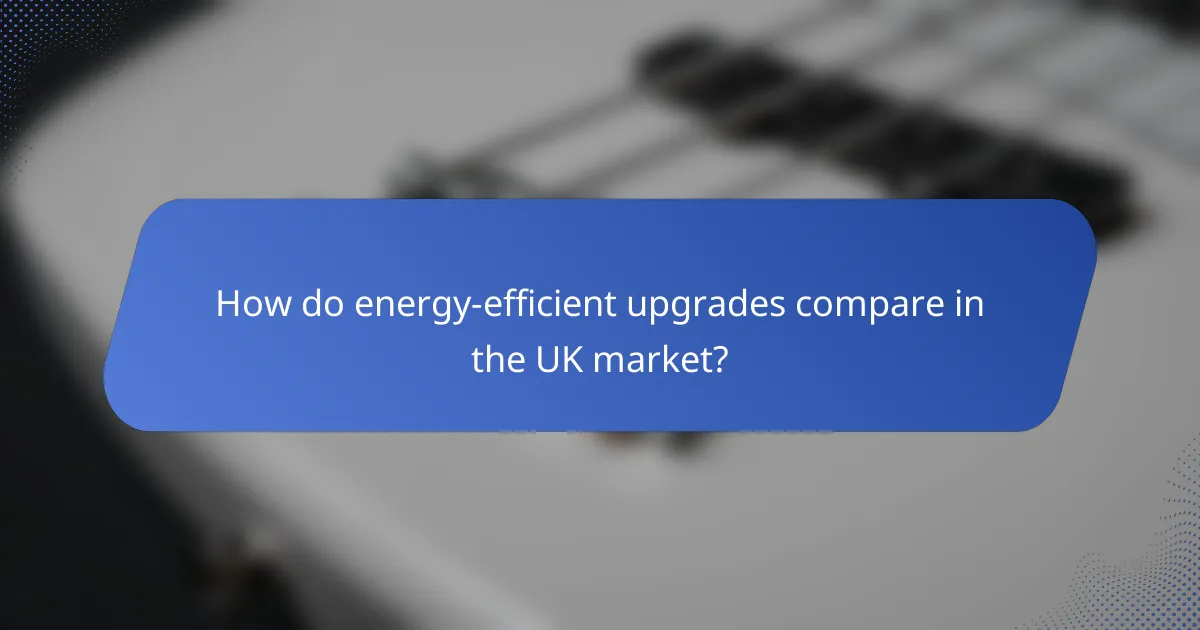
How do energy-efficient upgrades compare in the UK market?
Energy-efficient upgrades in the UK market can significantly reduce utility bills while contributing to environmental sustainability. These upgrades often involve modern technology that enhances energy performance, leading to long-term savings and reduced carbon footprints.
Cost-effectiveness of various upgrades
When considering energy-efficient upgrades, the cost-effectiveness varies widely depending on the type of improvement. For instance, installing double-glazed windows can yield savings on heating bills, often recouping the initial investment within a few years. In contrast, solar panel installations may require a higher upfront cost but can lead to substantial long-term savings on electricity bills.
Homeowners should evaluate the payback period of each upgrade. Generally, upgrades with shorter payback periods, such as LED lighting or smart thermostats, are more appealing for immediate savings, while larger investments like insulation or renewable energy systems may take longer but offer greater overall benefits.
Performance ratings of appliances
Energy-efficient appliances in the UK are rated using the Energy Label system, which ranges from A+++ (most efficient) to G (least efficient). Choosing appliances with higher ratings can lead to lower energy consumption and reduced bills. For example, an A-rated washing machine can use up to 50% less energy than a G-rated model.
When purchasing appliances, consumers should look for additional certifications, such as the EU Energy Label or the Energy Saving Trust recommendations, which provide further assurance of efficiency and performance. This can help in making informed choices that align with energy-saving goals.
Consumer satisfaction surveys
Consumer satisfaction surveys indicate that homeowners who invest in energy-efficient upgrades often report high levels of satisfaction due to reduced energy costs and improved comfort levels. Many users appreciate the immediate impact on their bills and the long-term benefits to their homes.
Surveys also reveal that consumers value the environmental benefits associated with energy-efficient upgrades, such as lower carbon emissions and a reduced ecological footprint. This growing awareness is driving more homeowners to prioritize energy efficiency in their renovation plans.

What are the latest trends in energy-efficient technology?
The latest trends in energy-efficient technology focus on smart systems, renewable energy integration, and advanced materials that reduce energy consumption. These innovations not only lower utility bills but also contribute to environmental sustainability by minimizing carbon footprints.
Smart Home Systems
Smart home systems are increasingly popular for enhancing energy efficiency. Devices such as smart thermostats, lighting controls, and energy monitoring systems allow homeowners to optimize energy use based on real-time data and personal habits.
For instance, a smart thermostat can learn your schedule and adjust heating or cooling accordingly, potentially saving up to 10-15% on energy bills. When selecting smart devices, look for compatibility with existing systems and user-friendly interfaces.
Renewable Energy Solutions
Renewable energy solutions, such as solar panels and wind turbines, are gaining traction as effective ways to reduce reliance on fossil fuels. These technologies can significantly lower energy costs over time, especially with government incentives and tax credits available in many regions.
Homeowners can expect to see a return on investment within a few years, depending on local energy prices and installation costs. Consider local regulations and available rebates when planning a renewable energy project to maximize savings.
Advanced Insulation Materials
Advanced insulation materials, like spray foam and reflective barriers, are essential for improving a building’s energy efficiency. These materials enhance thermal performance, keeping homes warmer in winter and cooler in summer, which reduces heating and cooling costs.
Investing in high-quality insulation can lead to energy savings of 20-30% annually. When upgrading insulation, ensure proper installation to avoid air leaks and maximize effectiveness.






